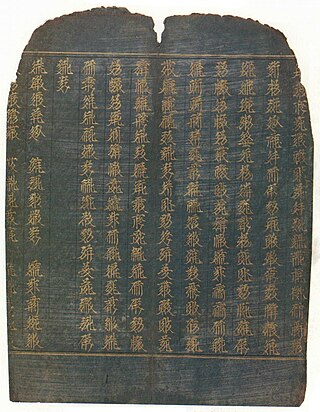In poetry, a couplet is a pair of successive lines that rhyme and have the same metre. A couplet may be formal (closed) or run-on (open). In a formal (closed) couplet, each of the two lines is end-stopped, implying that there is a grammatical pause at the end of a line of verse. In a run-on (open) couplet, the meaning of the first line continues to the second.

A nursery rhyme is a traditional poem or song for children in Britain and many other countries, but usage of the term dates only from the late 18th/early 19th century. The term Mother Goose rhymes is interchangeable with nursery rhymes.

A sonnet is a poetic form that originated in the poetry composed at the Court of the Holy Roman Emperor Frederick II in the Sicilian city of Palermo. The 13th-century poet and notary Giacomo da Lentini is credited with the sonnet's invention, and the Sicilian School of poets who surrounded him then spread the form to the mainland. The earliest sonnets, however, no longer survive in the original Sicilian language, but only after being translated into Tuscan dialect.

Mother Goose is a character that originated in children's fiction, as the imaginary author of a collection of French fairy tales and later of English nursery rhymes. She also appeared in a song, the first stanza of which often functions now as a nursery rhyme. The character also appears in a pantomime tracing its roots to 1806.

In Greek mythology, Hippocrene is a spring on Mount Helicon. It was sacred to the Muses and was said to have formed when the winged horse Pegasus struck his hoof into the ground, whence its name which literally translates as "Steed/Horse's Fountain". The water was supposed to bring forth poetic inspiration when imbibed.
In poetry, a tetrameter is a line of four metrical feet. However, the particular foot can vary, as follows:
Rhyme royal is a rhyming stanza form that was introduced to English poetry by Geoffrey Chaucer. The form enjoyed significant success in the fifteenth century and into the sixteenth century. It has had a more subdued but continuing influence on English verse in more recent centuries.

Ashtanga vinyasa yoga is a style of yoga as exercise popularised by K. Pattabhi Jois during the twentieth century, often promoted as a dynamic form of classical Indian (hatha) yoga. Jois claimed to have learnt the system from his teacher Tirumalai Krishnamacharya. The style is energetic, synchronising breath with movements. The individual poses (asanas) are linked by flowing movements (vinyasas).

Francis Vielé-Griffin, was a French symbolist poet. He was born at Norfolk, Virginia, USA, the son of General Egbert Ludovicus Viele, and moved to France with his mother in 1872.

"Ring a Ring o' Roses", "Ring a Ring o' Rosie", or "Ring Around the Rosie", is a nursery rhyme, folk song and playground singing game. Descriptions first emerge in the mid-19th century, but are reported as dating from decades before, and similar rhymes are known from across Europe. It has a Roud Folk Song Index number of 7925.
A children's song may be a nursery rhyme set to music, a song that children invent and share among themselves or a modern creation intended for entertainment, use in the home or education. Although children's songs have been recorded and studied in some cultures more than others, they appear to be universal in human society.

Tangut is an extinct language in the Sino-Tibetan language family.

The Bustan is a book of poetry by the Persian poet Saadi, completed in 1257 CE and dedicated to the Salghurid Atabeg Sa'd I or Sa'd II. Bustan is considered one of two major works of Saadi.

Satyajit Ray (1921–1992), a Bengali film director from India, is well known for his contributions to Bengali literature. He created two of the most famous characters in Feluda the sleuth and Professor Shanku the scientist. He wrote several short novels and stories in addition to those based on these two characters. His fiction was targeted mainly at younger readers, though it became popular among children and adults alike.

Shuntarō Tanikawa is a Japanese poet and translator. He is one of the most widely read and highly regarded of living Japanese poets, both in Japan and abroad, and a frequent subject of speculations regarding the Nobel Prize in Literature. Several of his collections, including his selected works, have been translated into English, and his Floating the River in Melancholy, translated by William I. Eliott and Kazuo Kawamura, won the American Book Award in 1989.
Nirjara is one of the seven fundamental principles, or Tattva in Jain philosophy, and refers to the shedding or removal of accumulated karmas from the atma (soul), essential for breaking free from samsara, the cycle of birth-death and rebirth, by achieving moksha, liberation.

Jain philosophy explains that seven tattva constitute reality. These are:—
- jīva- the soul which is characterized by consciousness
- ajīva- the non-soul
- āsrava (influx)- inflow of auspicious and evil karmic matter into the soul.
- bandha (bondage)- mutual intermingling of the soul and karmas.
- samvara (stoppage)- obstruction of the inflow of karmic matter into the soul.
- nirjara - separation or falling-off of parts of karmic matter from the soul.
- mokṣha (liberation)- complete annihilation of all karmic matter.
"Clair de lune", ("Moonlight") Op. 46 No 2, is a song by Gabriel Fauré, composed in 1887 to words by Paul Verlaine.

A bandha is a kriyā in Hatha Yoga, being a kind of internal mudra described as a "body lock," to lock the vital energy into the body. Bandha literally means bond, fetter, or "catching hold of".

The Gorakṣaśataka is an early text on Haṭha yoga text from the 11th-12th century, attributed to the sage Gorakṣa. It was the first to teach a technique for raising Kundalini called "the stimulation of Sarasvati", along with elaborate pranayama, breath control. It was written for an audience of ascetics.













